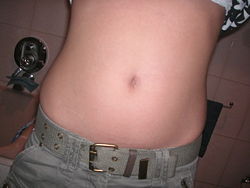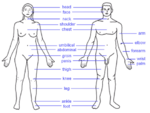Navel
| Navel | |
|---|---|
 |
|
| Human navel. The depression of the navel is often referred to as an innie. | |
| Latin | umbilicus |
The navel (also called an umbilicus or, colloquially, belly button) is a scar on the abdomen, caused when the umbilical cord is removed from a newborn baby. All placental mammals have a navel. While it is fairly conspicuous in humans, in most mammals it appears only as a thin hairless line.
In humans, the scar can appear as a depression (often referred to as an innie) or as a protrusion (outie). Although they can be separated into these two categories, navels actually vary quite drastically among people in terms of size, shape, depth/length, and overall appearance. As navels are essentially scars, and not in any way defined by genetics, they can serve as a way of distinguishing between identical twins in the absence of other identifiable marks.
Contents |
Human anatomy
This section focuses on externally-visible aesthetics of the navel in human anatomy. Information regarding fetal circulation -- how oxygenated blood and nutrients are absorbed by a fetus from the umbilical cord -- may be found under umbilical vein and umbilical artery, both of which are umbilical vessels.
The umbilicus is an important landmark on the abdomen since its position is relatively consistent among humans. The skin around the waist at the level of the umbilicus is supported by the tenth thoracic spinal nerve (T10 dermatome). The umbilicus itself lies at the level between L3/L4 vertebrae.

The reason for the occurrence of an outie is extra skin left from the umbilical cord or umbilical hernias, although a child with an umbilical hernia will not necessarily develop an outie. As well as the visible depression on a person's abdomen, the underlying abdominal-muscle layers also present a concavity; thinness at this point contributes to a relative structural weakness, making it susceptible to hernia. During pregnancy, the uterus presses the navel of the pregnant woman outward. It usually retracts after birth.
The umbilicus is also used to visually separate the abdomen into quadrants. The navel comes in the center of the circle enclosing the spread-eagle figure in Leonardo da Vinci's Vitruvian Man, his famous drawing on human proportions. This illustrates the principle that in the shift between the spread-eagle pose and the straight pose, the apparent center of the figure seems to move, but in reality, the navel of the figure, which is the true center of gravity, remains motionless.
Navels vary in height on the abdomen. An ideal proportion of navel height versus body height is said to be based on the Golden Section, also known as the "Divine Proportion" by philosophers and artists. This is a geometric proportion in which a line is divided so that the ratio of the length of the longer line segment to the length of the entire line is equal to the ratio of the length of the shorter line segment to the length of the longer line segment. This Golden Section ratio has a numerical value of approximately 1.618. In other words, an ideal navel height is about 62% of the body height and is said to exhibit special beauty as the legs and torso appear in sound proportion.
Some people have a smooth indentation instead of an "innie" or "outie", usually due to surgery for umbilical hernia, gastroschisis, or tummy tuck.[1]
Fashion

Fashion sometimes exploits the navel through clothing that leaves part of the lower abdomen (i.e., the midriff) bare, a usage that is much more common for women than for men. Displaying a bare navel has been and still is a taboo in certain Western cultures: for example, in the 1960s, Barbara Eden was not allowed to show her navel on the TV show I Dream of Jeannie.
The modern trend of exposing the navel has usually been confined to women, aside from a male belly-button shirt fad in 1980s fashion (men usually bare their navels only when they take their shirts off entirely).
Along with the acceptance of navel display in Western societies, navel piercing is becoming more common among young women. Short shirts that expose navels may also be worn to expose stomach/navel tattoos.
Sexuality
The navel's transfiguration from a vestigial fetal feeding tube to a person's erotic appendage can be ascertained from the attention it gets, ranging from a partner's casual stares to more intimate prodding. Navels can be the focus of sexual fetishism, especially among males. While cleavage of the breasts is certainly meant to display feminine charms and has a risqué, "turn-on" appeal, a navel can also be considered an object of sexual appeal. This attitude towards the navel (in contrast with breast cleavage) is shown in the hit '60's cult situation comedy Gilligan's Island. In Gilligan's Island, Ginger, the sexy movie star, often displays cleavage, but very rarely shows her navel, whereas Mary Ann, who's more the ingenue type, does sometimes show her navel, but does not show cleavage.
In the Song of Solomon, the book of Old Testament, there are allusions to exotic things in nature, with frequent interweaving of nature with erotic imagery. The navel figures in Solomon's lavish praise of his love (the country girl, Sulaimi) thus: "thy navel is like a round goblet, which wanteth not liquor"(7:2).
The modern-day Deirdre Day-MacLeod describes the navel's appeal thus: "Neither procreative nor nutritive, perhaps it is the navel's lack of obvious purpose, combined with its audacious, almost arrogant, spot right there in the middle of things, that sucks its admirers in."[2]
Other meanings
- The word "navel", or its equivalent in other languages, has been used sometimes for the center of something, e.g., "nave" of a wheel.
- Tortellini might represent the belly button of Venus, the Goddess of Love in Roman mythology (Aphrodite in Greek mythology).
See also
- Abdominal hair
- Granuloma
- Navel lint
- Navel fetishism
- Omphaloskepsis
- Omphalos
- Umbilical hernia
- Umbilicoplasty or Belly Button Surgery
References
- ↑ Who Doesn't Have a Belly Button? BBC News, 20 Nov 2008
- ↑ identity theory | nonfiction | navel gazing by deirdre day-macleod
|
|||||||||||||||||||
